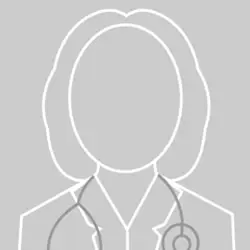Polycystic ovary syndrome (PCOS)
“Polycystic ovary syndrome requires rigorous evaluation and an individualized approach. Early diagnosis and a personalized therapeutic plan optimize symptom control, fertility, and metabolic prognosis.”
DR. ÁLVARO RUIZ
SPECIALIST. GYNAECOLOGY AND OBSTETRICS DEPARTMENT

What is polycystic ovary syndrome (PCOS)
Polycystic ovary syndrome (PCOS) is a common endocrine disorder in women of reproductive age. It is estimated to affect up to 13% of this population, and around 70% of cases may remain undiagnosed worldwide. It is a chronic condition without a definitive cure, but its course can be effectively controlled with early diagnosis and an individualized therapeutic plan.
PCOS is characterized by a hormonal imbalance in which the ovaries produce elevated levels of androgens (commonly known as “male hormones”). Although women naturally produce androgens, their excess can disrupt the menstrual cycle and prevent regular ovulation (anovulation), which is one of the most common causes of ovulatory dysfunction.
The Department of Gynecology and Obstetrics at the Clínica Universidad de Navarra provides comprehensive, personalized care for PCOS, based on protocols aligned with international guidelines and on multidisciplinary collaboration with Endocrinology and Nutrition, Dermatology, among other specialties. This coordinated approach enables timely diagnosis, the selection of the most appropriate treatment for each patient, and close follow-up aimed at improving gynecologic, metabolic, and reproductive health.

What are the symptoms of polycystic ovary?
Symptoms of polycystic ovary syndrome (PCOS) typically appear in late adolescence or the early twenties. It is important to note that not all women experience every symptom, and severity can vary considerably from person to person, ranging from mild to severe.
Menstrual cycle
The most common feature is menstrual irregularity: irregular cycles with infrequent periods (oligomenorrhea), and even absence of menstruation (amenorrhea). These disturbances reflect infrequent or absent ovulation (anovulation) and may be associated with difficulty conceiving. Some patients experience episodes of heavier or prolonged bleeding.
Hyperandrogenism
Excess androgens most commonly present as hirsutism (coarse hair on the face and/or body) and persistent acne beyond adolescence. Less frequently, androgen-pattern hair loss occurs (hair thinning at the crown and temples). Oily skin or seborrhea may also be present.
Associated metabolic manifestations
Common findings include a tendency to gain weight and abdominal fat accumulation, as well as signs of insulin resistance (e.g., acanthosis nigricans). Some patients present with prediabetes or type 2 diabetes, dyslipidemia, and other cardiometabolic risk factors.
Most common symptoms
- Irregular or widely spaced periods and/or absence of menstruation.
- Difficulty becoming pregnant due to anovulation.
- Hirsutism (facial/body hair).
- Persistent acne and oily skin.
- Androgen-pattern hair loss.
- Weight gain or difficulty losing weight; abdominal fat.
- Darkened patches on the neck/armpits (acanthosis nigricans).
It is important to note that not all women experience every symptom, and severity can vary considerably from person to person, ranging from mild to severe.
Do you have any of these symptoms?
If you suspect you are suffering from any of the above symptoms,
you should consult a medical specialist for diagnosis
What are the causes of PCOS?
The exact cause of PCOS is unknown. Scientific evidence points to a multifactorial interaction between genetic predisposition and metabolic and hormonal alterations that together promote androgen imbalance and ovulatory dysfunction.
Insulin resistance and hyperinsulinemia
Many patients with PCOS have insulin resistance, a condition in which cells respond inadequately to this hormone. The body compensates with hyperinsulinemia, which can stimulate the ovary to produce more androgens and disrupt ovulation. It is not present in all cases and can also be seen in women with a normal weight, although excess abdominal fat can worsen it.
Hormonal imbalances
Beyond elevated androgens (e.g., testosterone), there may be alterations in neuroendocrine regulation—such as changes in LH and its ratio to FSH, hormones that regulate the ovary—that impair regular ovulation and follicular maturation. This imbalance contributes to cutaneous symptoms and the menstrual irregularities typical of PCOS.
Genetic predisposition
PCOS often clusters in families, suggesting a polygenic hereditary basis. Genetics alone does not determine the development of the syndrome; its expression depends on the interaction with metabolic and environmental factors.
Associated complications
Ongoing medical follow-up is essential to monitor and address potential complications of polycystic ovary syndrome (PCOS) at an early stage.
Fertility and chronic anovulation
Infertility caused by ovulatory dysfunction is a common complication. Many women receive a PCOS diagnosis when seeking care for difficulty conceiving. Although PCOS can make pregnancy more challenging, it does not make it impossible; with an individualized approach and current treatments, the likelihood of conception is favorable.
Pregnancy (obstetric risks and follow-up plan)
Among women with PCOS who become pregnant, there is a higher likelihood of certain obstetric complications (gestational diabetes, hypertension and preeclampsia, miscarriage, and preterm birth), particularly when obesity is present. Preconception optimization (weight, blood glucose, blood pressure) and a close monitoring plan during pregnancy are recommended.
Close communication with the obstetrician-gynecologist helps tailor follow-up and allows early action if any issue arises.
Cardiometabolic risk
PCOS is associated with a higher risk of metabolic and cardiovascular disorders across the lifespan. Insulin resistance is a key factor that can lead to hyperglycemia, prediabetes or type 2 diabetes, along with dyslipidemia and other cardiometabolic risk factors.
Psychological impact
PCOS can significantly affect mental health and emotional well-being. Visible manifestations such as hirsutism, acne, hair loss, or weight gain may impact self-esteem and contribute to anxiety or depressive symptoms. Screening and psychological support, when needed, are part of comprehensive care.
How is polycystic ovary diagnosed?

The diagnosis of polycystic ovary syndrome (PCOS) is a clinical process that does not rely on a single test. It is based on a comprehensive assessment that includes medical history, physical examination, and various laboratory and imaging tests to rule out other conditions with similar symptoms.
Because symptoms can vary widely among women, specialists typically confirm the diagnosis when at least two of the following three main criteria are met (the first criterion must always be present), after excluding other possible causes:
- Signs of elevated androgen level (hyperandrogenism) detected clinically and/or with blood tests.
- Irregular or absent menstrual periods
- Polycystic-appearing ovaries on ultrasound:
Once the diagnosis is confirmed, care may be provided by a primary care physician or the patient may be referred to a specialist—such as an obstetrician-gynecologist (OB-GYN) or an endocrinologist—to establish a personalized management plan for symptom control and long-term risk prevention.
How is polycystic ovary syndrome treated?
The treatment plan is tailored to each woman, taking into account her specific symptoms, medical history, other health problems and whether or not she wishes to become pregnant.
Lifestyle plan: nutrition, physical activity
A focus on healthy eating and regular physical activity can significantly reduce many symptoms.
- Nutrition and physical activity: A healthy, balanced diet rich in fruits, vegetables, whole grains, lean meats, fish, and poultry is recommended. Consulting a registered dietitian for individualized nutrition counseling may be beneficial.
- Weight loss: In women with overweight or obesity, even modest weight loss (as little as 5%) can lead to meaningful improvement. This change may help regulate the menstrual cycle, improve insulin and cholesterol levels, and alleviate other symptoms such as acne and excessive hair growth. If needed, weight-loss medications can be considered.
- Sleep and stress: Prioritizing good sleep and managing stress supports hormonal balance.
Cycle regulation and symptom control
In women who are not seeking pregnancy, the priority is to regularize the menstrual cycle and relieve symptoms related to excess androgens, such as acne or hirsutism.
- Combined hormonal contraceptives (pill, patch, ring; estrogen + progestin): help regularize periods, reduce unwanted hair, and improve acne. They also provide an important long-term benefit: lowering the risk of endometrial cancer, which is higher in women with very irregular cycles.
- Progestin-only methods (e.g., levonorgestrel IUD, implant, progestin-only pill/minipill): useful when estrogens are not recommended. They protect the endometrium, can reduce bleeding, and help control symptoms.
- Intermittent progestin: cyclical progestin (for example, every 3–4 months) induces a regular menstrual bleed and reduces the risk of endometrial hyperplasia/cancer in cases with very infrequent or absent periods.
The choice of method is individualized, taking into account medical history, preferences, and potential contraindications.
Management of cutaneous hyperandrogenism
Excess androgens can lead to hirsutism (unwanted hair), acne, and androgen-pattern hair loss. Treatment is typically combined and stepwise, tailored to each patient’s goals.
- Antiandrogen medications (e.g., spironolactone): block the effects of androgens and help control hirsutism, acne, and androgenetic alopecia. They are often prescribed together with hormonal contraceptives. They should not be used during pregnancy and require medical supervision. A response is typically seen after 3–6 months.
- Topical treatments and procedures:
- For facial hair: eflornithine cream to slow growth; may be combined with laser hair removal or electrolysis (multiple sessions; best results when hyperandrogenism is controlled).
- For acne: topical retinoids, benzoyl peroxide, and, when appropriate, antibiotics or systemic therapies under medical guidance.
- For hair loss: topical minoxidil and a trichology-directed approach; results require consistency (3–6 months).
Insulin resistance: possible approaches
Insulin resistance is common in PCOS and contributes to androgen excess and cardiometabolic risk.
- Sensitizing medications: metformin improves insulin sensitivity and may reduce androgens, promote ovulation, and regularize the cycle. It should be used under medical supervision, with attention to gastrointestinal tolerance, long-term vitamin B12, and renal function.
- Lifestyle (core pillar): a healthy diet and regular physical activity improve insulin sensitivity and weight management.
- Other options in selected cases: GLP-1 receptor agonists (when obesity is present) and, if diabetes is present, SGLT2 inhibitors, always individualizing indications and safety.
Where do we treat it?
IN NAVARRA AND MADRID
The Department of Gynecology and Obstetrics of the
of the Clínica Universidad de Navarra
Comprehensive care that includes a wide range of consultation and treatment options from regular preventive screening to the most advanced diagnostic and treatment options for obstetric and gynecological problems at all ages.
The department also offers routine pregnancy monitoring that includes a variety of diagnostic and screening procedures to identify potential problems of the fetus as well as its proper growth and development.
Diseases we treat
- Gynecological Cancer
- Prenatal diagnosis
- Endometriosis
- Urinary and fecal incontinence
- Masas anexiales
- Menopause
- Polycystic ovary syndrome
- Uterine Myomas

Why at the Clinica?
- Highly specialized team of doctors, nurses and midwives.
- Reproduction and Fertility Unit.
- Pregnancy follow-up with a personalized delivery.
- All the comfort, with the guarantee and safety of a hospital with the most advanced equipment.

























